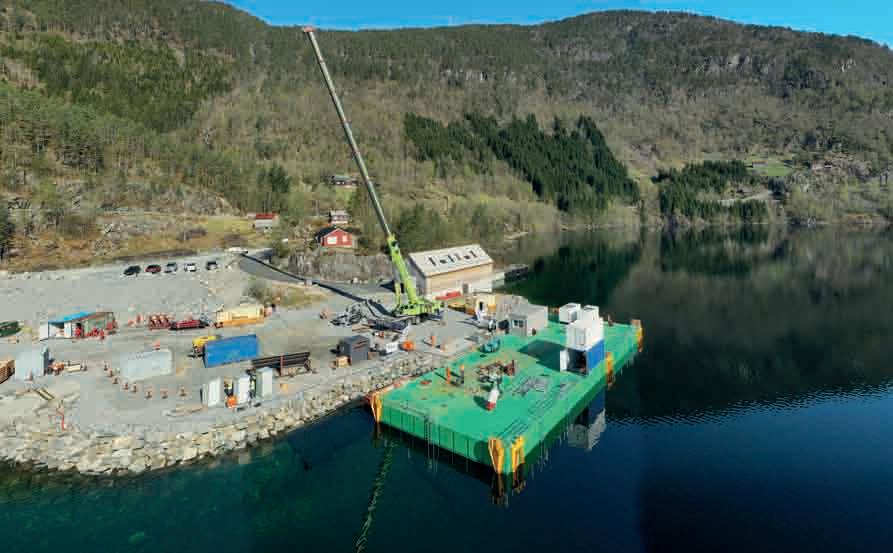
4 minute read
project North Sea Link passes halfway point
North Sea Link passes halfway point
Before being able to lay the cable in Norway, the team first had to tackle manoeuvring the cable through a lake, using a custom-made floating platform.
CONSTRUCTION OF THE LONGEST SUBSEA POWER CABLE IN THE WORLD RECENTLY PASSED ITS HALFWAY POINT AND ACHIEVED A MAJOR ENGINEERING FEAT TO ENABLE NORWAY’S ZERO CARBON HYDRO ENERGY TO BE SHARED WITH THE UK.
North Sea Link, a joint venture project between National Grid and Norwegian system operator Statnett, is a EUR 2 billion Interconnector project. When wind power production in the UK is high, Norway will be able to import power at a lower price than in the Nordic market, helping conserve the water in the country’s hydropower reservoirs. At times when there is little wind in the UK, it can then import Norwegian hydropower at a lower price than in the UK while helping to ensure the security of power supplies.
720km North Sea Link will connect the electricity transmission systems between the UK and Norway via 720km of subsea cables. The interconnection will be established through two parallel high voltage direct current (HVDC) cables that will run from Kvilldal in South West Norway to East Sleekburn on the Northumberland coast, passing through Norwegian and British waters. They will be buried between 1m and 3m into the seabed using a range of installation techniques suited to the seabed conditions. A desktop cable routing study and detailed offshore survey was undertaken for the optimal route, and an Environmental Report was prepared. The seabed survey was carried out using non-intrusive methods (geophysical) and intrusive methods (geotechnical) to provide information on the seabed type, for both engineering and environmental purposes.
Custom-made platform Before being able to lay the cable in Norway, the team first had to tackle manoeuvring the cable through a lake, which cannot be accessed by the size of vessels usually required for cable laying. Instead, the team transported materials piece by piece to build their own custom-made floating platform. The operation is the first of its kind on this scale in Norway and the construction of the platform had an average of 25 people working on it daily over the course of eleven days. This unique operation in Suldalsvatnet marks the start of the cable laying on the Norwegian side. Working at depths of up to 210m, the laying of the 2.8km parallel subsea cables was executed from a 43 x 15m platform – equivalent to the size of two tennis courts. The equipment required to lay the cable was then installed on the platform and within twelve hours, 150t of cable was loaded on board. The platform held all necessary equipment that is usually found on offshore cable laying vessels. Nigel Williams, Construction Director for National Grid North Sea Link, says, “The engineering that has taken place to lay high-voltage cables below the seabed is remarkable. The difficult terrain, >>
The North Sea Link cables will run from Kvilldal in South West Norway to East Sleekburn on the Northumberland coast, passing through Norwegian and British waters.

the depth of the waters, and all amidst operating during a pandemic has made it extremely challenging. Nevertheless, we have powered through and remained on track with our project timelines.”
Electrical transformers Another major milestone in the North Sea Link Interconnector project was reached on the UK side of the project earlier this year with the delivery of seven new electrical transformers from the Port of Blyth to the Converter Station site at Cambois in Northumberland. The transformers, weighing approximately 220t each, were manufactured in Sweden by ABB Transformers Ludvika and shipped to Blyth. The transformers are sophisticated electrical equipment that plays a crucial role in the renewable energy sharing project. Each one changes the voltage of electricity by converting the alternating current from one voltage to another, so that electricity can be delivered to customers on both sides of the North Sea. Due to the size and weight of the transformers, specialist

transportation was used to complete the final leg of their journey. Mike James, Site Manager at North Sea Link in Cambois, comments, “Transporting electrical equipment of this size and scale requires months of advanced planning and consideration. The oversized load set off from Sweden by rail and arrived at the Port of Blyth at the end of last year, where they’ve remained in storage whilst work progressed on site. Their arrival at Cambois is a big milestone for the project and the
The team had to transport materials piece by piece to build the floating platform.
Photo courtesy of National Grid.
transformers will play a huge role in transporting clean, green renewable energy between the UK and Norway.”
Next milestone Following this major feat of engineering, the following milestone is to lay the cable from the fjords in Suldal to the North Sea. This work will be carried out throughout the remainder of the year and by 2021, the two parallel 720km cables between Cambois, Northumberland, and Kvilldal will have been completed to make North Sea Link the longest subsea power cable interconnector in the world. The licence for the construction of North Sea Link was given in 2014. Preparational work started in Norway in 2015 and in 2017 in the UK. By 2021, North Sea Link will be operational and the 1.4GW electricity interconnector will allow the UK to import enough clean energy to power up to 1.4 million homes.










